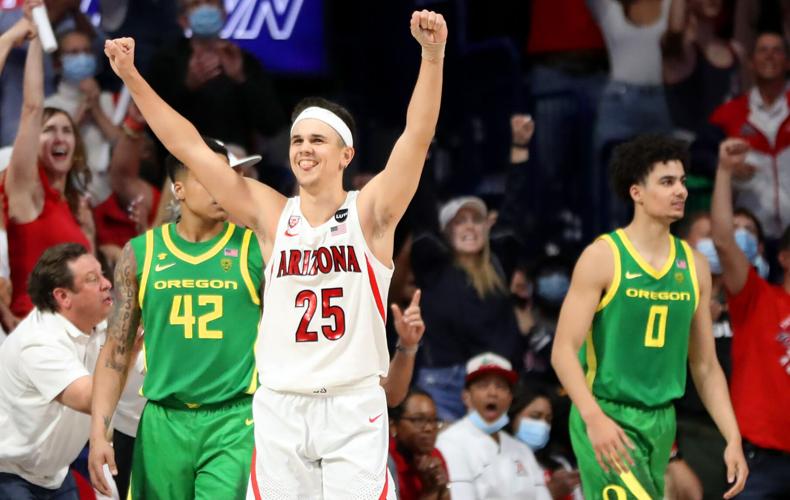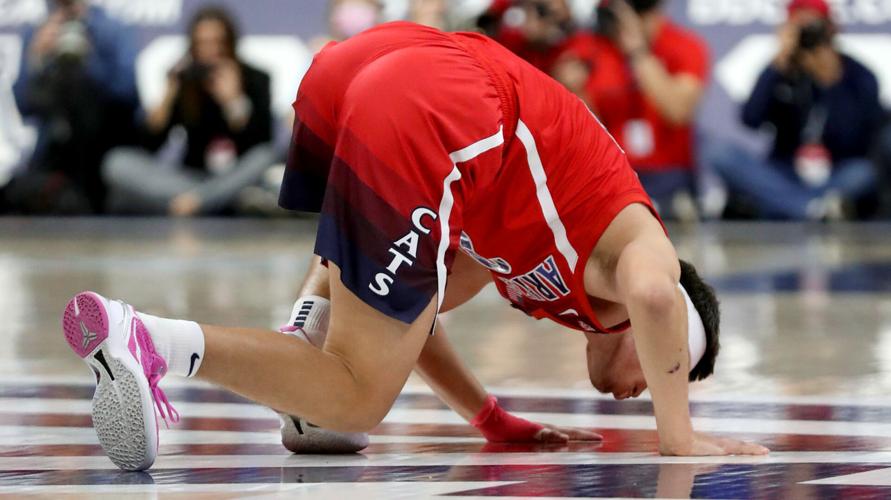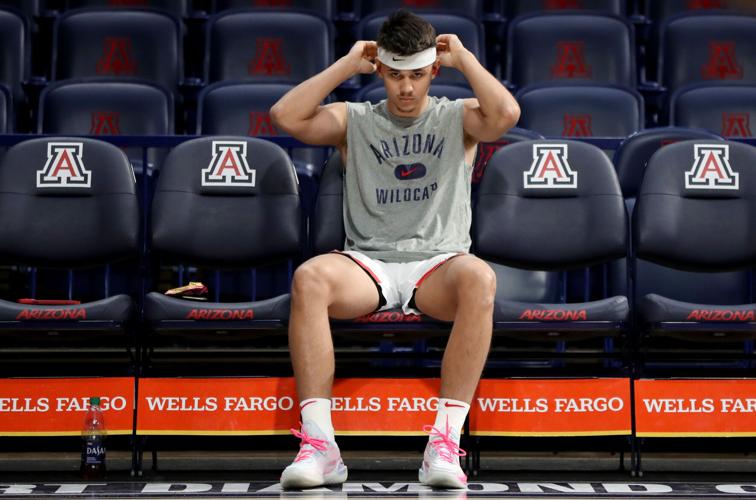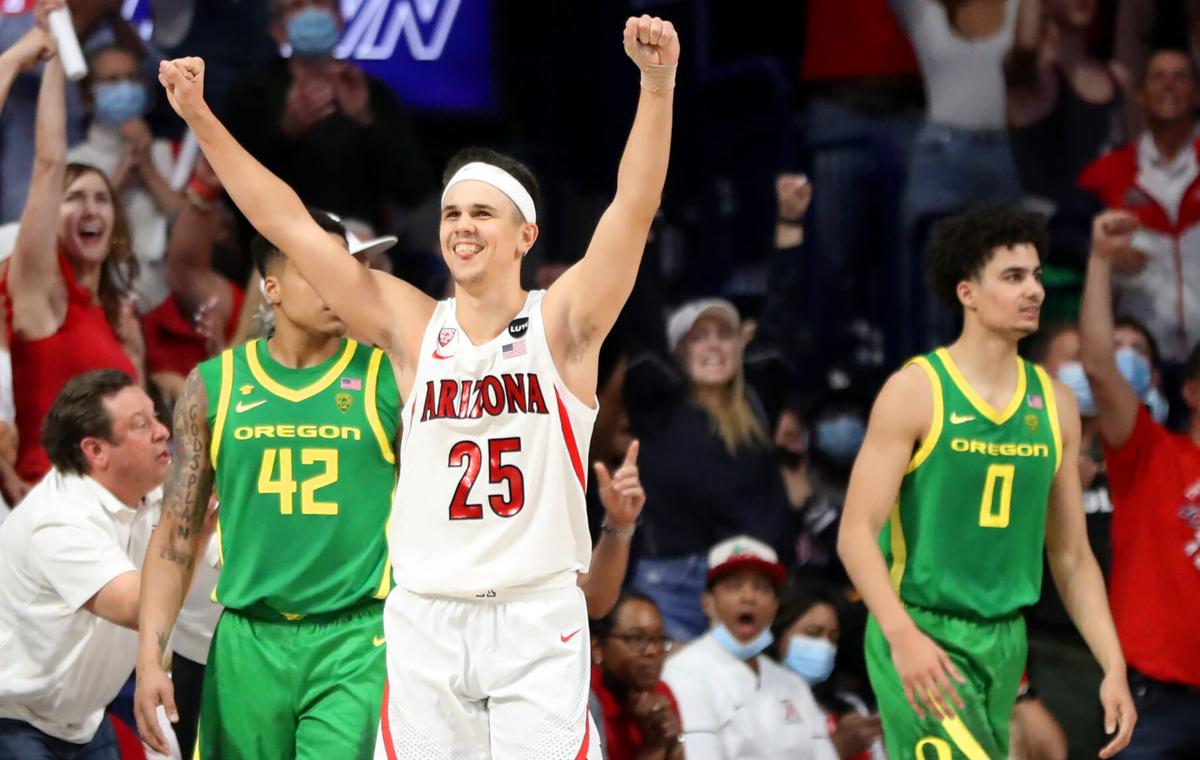Part of Kerr Kriisa’s pregame routine at McKale Center is to step away from the layup line and schmooze with the referees. Hey, man, good to see you.
Before the Oregon game last month, Krissa stood, unfazed, between Final Four referees Randy McCall and Verne Harris; whatever he was saying seemed to be working. McCall laughed a few times. Kriisa had his arm on Harris’ shoulder. They bumped fists and smiled at one another.
A few weeks earlier, before the USC game, Kriisa approached referee Tony Padilla, who worked back-to-back Final Fours in 2016 and 2017 and is probably the Pac-12’s most respected official. Padilla is a no-nonsense type, a bail bondsman from Sacramento who isn’t likely to fall for anyone’s schtick.
Yet Kriisa engaged Padilla in conversation near mid-court, patting Padilla on the back after their minute together. And at last month’s UCLA-Arizona game at McKale, Kriisa stopped shooting jumpers to visit with Final Four ref Dave Hall.
Kriisa appeared to be asking for Hall’s opinion on a rules issue. Kriisa shuffled his feet and looked at Hall with a palm extended upward, as if to ask, “Is that legal?”
One category not in the box scores is “working the refs.” But game after game, I sit at press row and watch Kriisa leave the layup line to chat with the officials. Who does that? I can’t remember Matt Muehlebach or Jason Terry or T.J. McConnell doing it. For Kriisa, the game begins before tipoff. He’s always trying to get an edge.
A lot of Arizona basketball followers refer to Kriisa in old-fashioned terms. Showboater. Grandstander.
They don’t like it.

Arizona guard Kerr Kriisa takes a second to kiss the “A” logo at midcourt after he scored, breaking a lengthy scoring streak, against ASU on Jan. 29.
A lot go the other way: They like his spunk, his headband, his hot-dog nature. If you can get a neutral opinion on the emotions-on-his-sleeve Kriisa, you are probably not talking to a genuine UA basketball fan.
During one game at McKale this season, I watched Tommy Lloyd shout “ZIP IT!” when Kriisa reacted angrily to an official’s whistle. But Kriisa isn’t a “zip it” kind of ballplayer. A few moments after Arizona’s chilling victory over TCU on Sunday, Kriisa grabbed an Estonian flag from someone in the bleachers and jogged toward Horned Frogs fans, taunting them.
It seemed to take a lot of brass for someone to taunt the Horned Frogs after shooting 1 for 10.
But in a postgame interview, Lloyd spotted something in the box score that went beyond Kriisa’s shooting numbers. In the 26½ minutes Kriisa was on the court, Arizona outscored TCU by 24 points.
“The crazy thing is Kerr goes 1 for 10 from 3,” said Lloyd. “But to play 26 minutes recovering from a sprained ankle, and to have a plus/minus of 24, I think that tells you what he means to our team.”
The emails roll in, stirred by Kriisa’s performance, good and bad. Here’s an example of my inbox after the TCU game:
“Kerr Kriisa’s classless display to the Horned Frog faithful is typical for him and his swagger, which reminded me of how much Duke’s Bobby Hurley was disliked by everyone outside of the Duke fans during his playing days.”
“We wavered between screams of elation and moans of despair. There was a joy when Kerr took the floor that was felt from San Diego to Tucson. If I remember, we were five down as he checked in, and five up when he sat down.”
“In a game with so much at stake, if you come out on top you’re going to blow off a lot of steam. But it could be done without the mocking the other team.”

Arizona guard Kerr Kriisa gets the headband just right before heading out for the team’s workout prior to the team’s March 3 game against Stanford.
The great fear about this and every NCAA Tournament is how Arizona can survive if its point guard doesn’t (a) shoot well or (b) play close to error-free. In the UA’s Final Four seasons its longevity was linked to point guard efficiency more than anything else.
Steve Kerr, 1988: Kerr shot 2 for 13 in the Final Four loss to Oklahoma. That was the year Kerr set the NCAA record by shooting 57% from 3-point distance.
Damon Stoudamire, 1994: Stoudamire shot 5 for 27 in the exit loss to Arkansas. But it should also be said that Arizona beat Louisville in the Sweet 16 when Stoudamire shot 2 for 12.
Mike Bibby, 1997: One of the chief reasons Arizona won the national championship was because Bibby, a freshman, didn’t have anything resembling an off-shooting night. Over six games, Bibby averaged 18 points and shot 48% from 3-point range, which exceeded his regular-season average of 44%.
Alas, a year later in the Elite Eight, Bibby had the worst game of his career, shooting 0 for 7 from 3-point distance and was just 3 for 15 overall, with seven points. In his previous nine NCAA Tournament games, Bibby shot 53% from 3.
Jason Gardner, 2001: A gamer if ever there was one, Gardner shot 2 for 11 (and 0 for 8 on 3s) in the national championship game against Duke. The pressure of the NCAA Tournament can be seen in Gardner’s statistics over 15 NCAA games. He shot just 27% on 3-pointers, compared to his career average of 36%.
That decline of 9% can make all the difference. What I’m trying to say here is that Arizona probably can’t survive another 1-for-10 shooting night from its point guard.
Maybe it’s unfair to compare Kriisa to the UA’s Final Four point guards. After all, Kriisa had played just 83 minutes of college basketball entering this season. Gardner had played 1,244 before his Final Four season, Stoudamire 1,410 and Kerr an astounding 2,897 minutes. But it’s too late to worry about that; Arizona is on the big stage and Kriisa is running the show.
Kriisa brings more than statistics. He brings fearlessness, not caution. He brings passion, if not poise. He’s not likely to zip it now.







